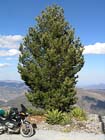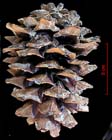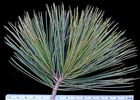
P. stylesii in habitat on Cerro Potosí, Nuevo León (24.890°N, 100.226°W; elev. 3080 m) [C.J. Earle, 2007.02.19].

Cone collected in habitat on Cerro Potosí, Nuevo León [C.J. Earle, 2007.02.20].

Foliar unit collected in habitat on Cerro Potosí, Nuevo León [C.J. Earle, 2007.02.20].

Needle fascicle collected in habitat on Cerro Potosí, Nuevo León [C.J. Earle, 2007.02.20].

Saplings of (left to right) P. culminicola, P. hartwegii and P. stylesii growing together on Cerro Potosí, Nuevo León [C.J. Earle, 2007.02.20].

Pinus stylesii
Frankis ex Businsky 2008
Common names
Taxonomic notes
The earliest recorded collection is in 1934 (C. H. Mueller & M. T. Mueller 1244,
Cerro Potosí, 1934.07.26 [F]). Prior to description of the species, it was described by various authorities as P. flexilis, P. flexilis var. reflexa, or P. strobiformis. These are, with Pinus strobiformis subsp. veitchii, the species' closest relatives, and together they form a clinal complex of white pines that extends from British Columbia to Michoacán. See P. strobiformis for further discussion of this complex. P. stylesii displays characters that consistently deviate from the similar species named above and a study of chloroplast microsatellite loci has demonstrated that it has a haplotype composition related to both P. strobiformis and P. ayacahuite, yet substantially different from either (Moreno-Letelier and Piñero 2009).
Description
Tree up to 25 m tall, with a trunk up to 60 cm diameter. Bark gray smooth on young trees, becoming square-cracked with age. Needles in bundles of five, 6-12 cm long, outer face glossy green, inner faces with conspicuous blue-white stomatal bands, margins fully serrulate, sheath deciduous. [Pollen cones not described.] Seed cones 12-25 cm long, 8-13 cm broad when open (smaller in exposed, high elevation trees), green ripening yellow to orange-buff; scales straight or reflexed (not recurved), moderately thick, striated, orange-buff, apex acute, basal scales numerous and congested. Seeds 13-18×8-11 mm, the longest seed of any American white pine, with a rudimentary wing 0.5-2(-4) mm long (Frankis 2008a, 2008b).
Resembles P. flexilis (both the type and var. reflexa), but P. stylesii has broader cones and longer seeds, as well as consistently serrated needles (entire in P. flexilis, weakly serrulate in P. flexilis var. reflexa) with stomata only on the inner faces. Also resembles P. strobiformis, but P. stylesii has straight (not recurved or revolute) and slightly thinner cone scales, a shorter apophysis prolongation with an acute (not rounded) apex, and relatively longer, less rounded seeds (Frankis 2008b).
Distribution and Ecology
Mexico: Coahuila and Nuevo León, at altitudes of 2300 m to 3600 m, often on limestone soils (Frankis 2008b). Most collections have occurred on Cerro Potosí, Nuevo León.
Cerro Potosí is a remarkable place in many ways. It is a gigantic limestone monolith in westernmost Nuevo León. There are a couple of minor peaks to the west and northwest that approach it in altitude (over 3,700 meters), but apart from these, it is the tallest thing for several hundred kilometers in any direction. Biogeographically, it is an extraordinarily isolated island, and contains a goodly number of endemic plant species. Among these is Pinus culminicola, a piñon, arguably the world's smallest pine (up to 3 m tall). The top thousand meters or so of the mountain are dominated by a conifer forest of, from the top down, Pinus culminicola, Pinus hartwegii, Pinus stylesii, Pinus strobiformis, Pseudotsuga menziesii subsp. glauca, Abies vejarii, and Pinus arizonica var. stormiae. Still lower are Pinus cembroides, Pinus greggii, and Pinus nelsonii. It is a Mecca for rare pines.
Remarkable Specimens
Ethnobotany
Observations
I have only seen it in Nuevo León, growing high on Cerro Potosí (above 2900 m), where it is reasonably common along the main road that leads to the summit. This is where most herbarium collections have occurred. Other recent collections were in Coahuila: Zaragosa: Cañada las Tinajas (2500-2600 m elevation), and in the Parque Natural Sierra de Arteaga, east of Saltillo. As far as I know there are no living specimens in collections.
Remarks
The epithet commemorates Brian Styles (1934-1993), formerly of the Oxford Forestry Institute and senior author of Farjon and Styles (1997).
Citations
Frankis, Michael. 2008a. Pp. 6-7 in Roman Businský, The Genus Pinus L., Pines: Contribution to Knowledge. Acta Pruhoniciana 88:1-126 (2008.07.01, ISBN 978-80-85116-60-1).
See also




